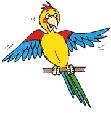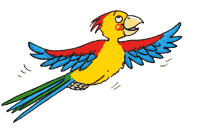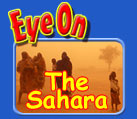| |
| Everything
was carried on camels in lines called ‘caravans’.
Caravans would vary in size but sometimes they had
over one thousand camels! |
|
 |
Timbuktu
is one of the places marked on the map - you
may have heard of it before. Timbuktu is sometimes
used in a phrase to describe a place that is very
far away. But Timbuktu is a real town in Mali, and
for centuries it has been an important stopping
point in the Sahara. In fact, Timbuktu had the best
university in the Sahara region in the 14th century!
Timbuktu was nicknamed the ‘Oxford of Africa’
because of it. |
| The
table shows how far it is from one trading place
in the Sahara to another. |
|
| (Km) |
Agades |
Cairo |
Gao |
Fez |
Marrakesh |
Timbuktu |
Tunis |
| Agades |
- |
2,2850 |
450 |
2,100 |
2,250 |
1,200 |
2,250 |
| Cairo |
2,850 |
- |
3,300 |
3,300 |
3,750 |
3,900 |
1,950 |
| Gao |
450 |
3,300 |
- |
2,100 |
1,950 |
750 |
2,400 |
| Fes |
2,100 |
3,300 |
2,100 |
- |
450 |
1,950 |
1,500 |
| Marrakesh |
2,250 |
3,750 |
1,950 |
450 |
- |
1,800 |
1,950 |
| Timbuktu |
1,200 |
3,900 |
750 |
1,950 |
1,800 |
- |
2,700 |
| Tunis |
2,250 |
1,950 |
2,400 |
1,500 |
1,950 |
2,700 |
- |
 |
Ahmed is a
trader who lives in Timbuktu. He travels great distances
with his camel, Abdul to take palm leaves to different
markets. The palm leaves are made into baskets,
mats and brooms. |
 to
download a worksheet to calculate how far Ahmed and
Abdul have to travel on different journeys, using the
table of distances to and from markets in the Sahara
region. to
download a worksheet to calculate how far Ahmed and
Abdul have to travel on different journeys, using the
table of distances to and from markets in the Sahara
region.
After you have
finished the worksheet,
 to
see how well you did. to
see how well you did.
| The table
gives the direct distances from each place - we
sometimes say, ‘as the crow flies’.
But these are not the distances that people like
Ahmed will actually travel. Can you think of any
reasons why there is a difference between the direct
distances and the actual distances they travel? |
|
 for
some answers. for
some answers.
 |
In the past,
traders like Ahmed bought and sold gold, salt, and
even ostrich feathers across the Sahara. Today,
trading is less important because of new ways of
transporting goods. Can you think of some? |
|
|
